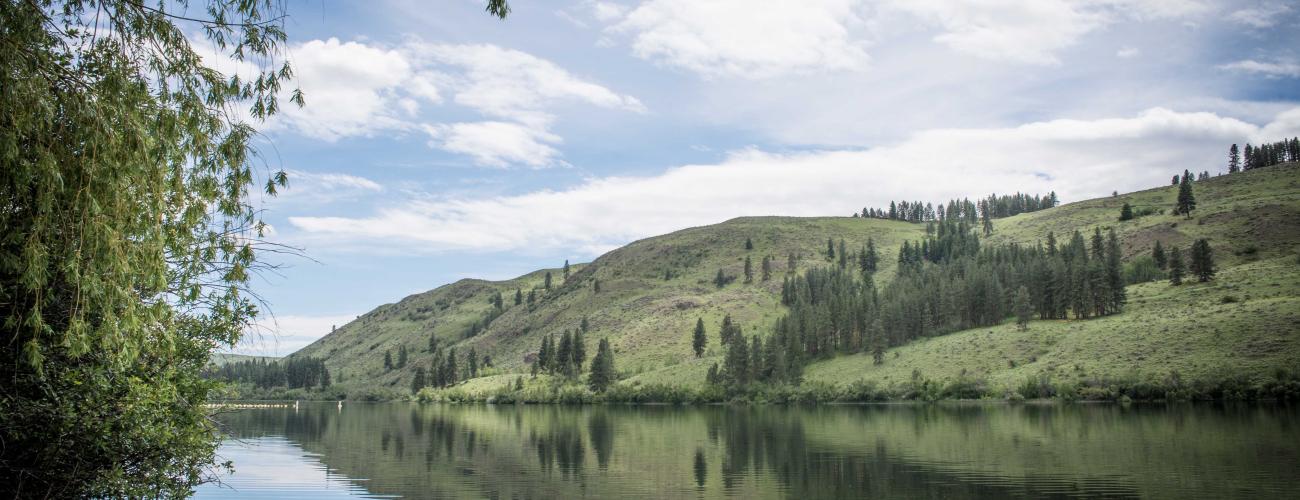Pearrygin Lake State Park History
Formed by Glacial Meltwaters
Pearrygin Lake owes its existence to a quirk in the timing of melting glaciers. At the close of the Pleistocene ice age around 13,000 years ago, the huge Methow Valley glacier responsible for deepening the U-shaped Methow Valley persisted later than the tongues of ice that had flowed into the Chewack River Valley from a giant ice cap centered in today’s British Columbia. Meltwater from the ice cap was blocked by the Methow Valley glacier and spilled over the low divide east of today’s town of Winthrop, scouring the depression that would later be filled by Pearrygin Lake.
Indigenous Land
Pearrygin Lake lies within the traditional territories of Interior Salish Indigenous people whose present-day descendants include members of the Methow Band of the Confederated Tribes of the Colville Reservation and Confederated Tribes and Bands of the Yakama Nation. For thousands of years these foothills of the Cascade Mountains and the rivers that flow through them have provided habitat for a diverse community of life that forms the basis of their cultures.
Members of the tribes occupying this area were not represented at the Walla Walla Treaty Council held by Territorial Governor Isaac Stevens on June 9, 1855. Subsequently, an Executive Order of President Rutherford B. Hayes on April 18, 1879, created the Columbia (or “Moses”) Reservation, roughly covering the same area as today’s Okanogan County west of the Okanogan River extending southwest to the north shore of Lake Chelan. Non-tribal miners living in the area protested the order. On July 4, 1884, President Chester A. Arthur dissolved the reservation, and the relinquished land became the public domain of the US federal government. On May 1, 1886, the area was formally opened for settlement.
Settler Homesteads
The land at the heart of today’s Pearrygin Lake State Park passed into private ownership as Homestead Patents to several individuals. The first settler, Civil War veteran Benjamin Franklin Pearrygin, staked his claim in 1887. The US Government survey for the area was completed on June 7, 1895. Pearrygin “proved up” his claim by building a house and raising crops, receiving a patent for 169 acres on October 21, 1898.
Another settler, Guy Waring, founded the town of Winthrop and introduced railroad and highway promoter Sam Hill to Pearrygin Lake in 1905. Hill, who later financed and built the Peace Arch on the US-Canada border, was enchanted with the location and purchased most of the homestead properties around the lake with the intention of establishing a ranch for his son James Nathan Hill. Guy Waring managed the property in his absence, but James Nathan Hill only visited the property once, when he was 12 years old. When Sam Hill died in 1931, his estate sold the property.
Water for Irrigation
The homesteaders that claimed lands around Pearrygin Lake and elsewhere in the Methow Valley sought to increase the value of their land with irrigated agriculture, including fruit orchards. In 1910, local investors created the Chewack Canal Company to distribute water. They built a canal to carry water from a mountain stream to Pearrygin Lake, where it could be stored. A concrete and earth fill dam finished in 1921 at the lake’s outlet raised its level five feet for more storage capacity. Today, the canal system stretches 13 miles and supplies water to about 185 customers growing alfalfa, vineyards, fruit orchards and more.
Recreation on the Water and in the Snow
On May 20, 1959, the Washington Parks and Recreation Commission (WSPRC) purchased 500 acres on the east side of the lake, including much of the homesteaded lands that had been included in Sam Hill’s ranch. Adjacent public domain lands that had not been homesteaded were transferred from the US federal government for recreation and park purposes in 1964. A series of purchases from 2004-2006 added the lands of the original Pearrygin homestead and substantial land on the western side of the lake.
A primary attraction for visitors to Pearrygin Lake State Park is the chance to fish for rainbow trout. The Washington Department of Fish and Wildlife stocks thousands of trout from the Wells Hatchery in its waters most years in the early spring.
In 2011, construction of the Rex Derr Trail began. The trail, which nearly circumnavigates the lake crosses shrub-steppe hillsides with gorgeous views and passes structures remaining from the homesteading era. Its name honors the director of Washington State Parks who served in that capacity from 2002-2010.
The Methow Valley is renowned for its clear, cold, and snowy winters. On June 18, 1975, Washington Governor Daniel J. Evans approved House Bill Number 762, authorizing the WSPRC to maintain plowed parking areas (Sno-Parks) for winter recreational activities funded by fees from parking permits. Pearrygin Lake State Park hosts a Sno-Park area with miles of trails groomed for Nordic skiing, snowshoeing, walking, and fat-tire biking. Staff groom the trails with snowmobiles and grooming rollers, enabling the park to offer year-round recreational opportunities.
Sharing the histories of Washington’s state parks is an ongoing project. Learn more here.

